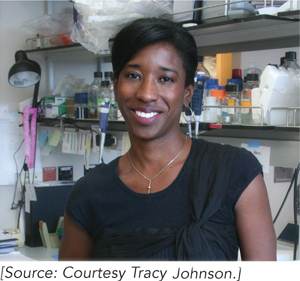Chapter Introduction
21: The Transcriptional Regulation of Gene Expression in Eukaryotes
727
MOMENT OF DISCOVERY

Our lab has been trying to understand how pre-
The real moment of surprise came when we found that when the GCN5 gene is deleted, cotranscriptional splicing is completely messed up! This is because the U2 snRNP is no longer recruited to pre-
—Tracy Johnson, on discovering that pre-
728
Eukaryotic cells, like bacteria, express only a subset of their genes at any given time. We saw in Chapter 20 that bacteria, through gene regulation, are able to adapt to environmental changes and respond to signaling molecules and viral assaults. Eukaryotes, too, must respond to their environment and external stimuli. But in addition, multicellular eukaryotes must manage complex pathways of cell division and differentiation that give rise to the multitude of cell types required for organismal development. Developmental programs are extremely precise—
Recall that many bacterial genes and operons are regulated at the level of transcription initiation. This is true in eukaryotes as well, and as we will see, many eukaryotic regulatory mechanisms build on those used in bacteria. However, there is a fundamental difference between bacterial and eukaryotic regulation of transcription. The transcriptional ground state, the inherent activity of promoters and transcription machinery in vivo in the absence of regulatory mechanisms, is not the same in bacteria and eukaryotes. In bacteria, the transcriptional ground state is nonrestrictive; RNA polymerase generally has access to every promoter and can bind and initiate transcription at some level of efficiency in the absence of activators or repressors. In contrast, eukaryotic genes contain strong promoters that are generally inactive in the absence of regulatory proteins—
Crucial differences in DNA packaging and cell structure give rise to at least four important distinguishing features of regulation of gene expression in eukaryotes. First, access to eukaryotic promoters is restricted by the structure of chromatin, and transcriptional activation is associated with many changes in chromatin structure in the transcribed region. Second, although eukaryotic cells have both positive and negative regulatory mechanisms, positive mechanisms predominate in all systems investigated so far; given that the transcriptional ground state is restrictive, virtually every eukaryotic gene requires activation. Third, eukaryotic cells have larger, more complex, multiprotein regulatory networks than bacteria. And finally, transcription in the nucleus is separated from translation in the cytoplasm, in both space and time. As a result, posttranscriptional control plays a larger role in controlling gene expression in eukaryotes, as we will see in Chapter 22.
The complexity of regulatory circuits in eukaryotic cells is extraordinary, and we will not attempt comprehensive coverage of all aspects. This chapter and the next cover some of the guiding principles of eukaryotic gene regulation, drawing parallels to the mechanisms discussed for bacteria in Chapter 20, wherever applicable. The need to control the multitude of genes in a higher eukaryote requires an array of regulatory proteins for every single gene. We begin by discussing the basic logic of gene activation as used in essentially all eukaryotes. We take a brief look at experiments that first revealed the modular architecture of gene activators and highlight some of the regulatory networks that govern gene expression, from the simple system in yeast to the complex developmental controls typical in a multicellular eukaryote. The chapter concludes with a discussion of transcriptional control processes unique to eukaryotic gene expression, some of which are still far from understood.